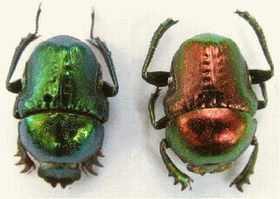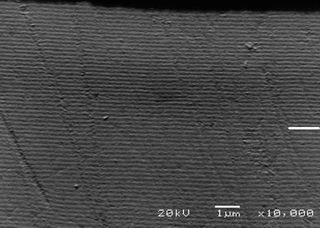April 11, 2007 feature
Beetles' bright colors may influence new light technology

In studying the bright green and red colors on a species of scarab beetle, scientists have found that the unusual reflection spectra is caused by defects in the structure of the exocuticle, or hard shell. Understanding how this structure causes the bright colors may help scientists design nano chiral reflectors for use in display and laser technologies in the future.
While more than 30,000 species of scarab beetles exist throughout the world, the species studied by the scientists was Gymnopleurus virens, which is found mainly in southern Africa. In the early 1900s, scientists found that this scarab beetle reflected almost entirely left-handed (left circularly polarized) light, and almost no right-handed light—the only known example of this phenomenon in nature.

Decades later, scientists discovered the reason for this asymmetrical preference. The beetle’s shell consists of many layers of microfibrils aligned parallel with each other, which causes a preference for light polarized along the direction of the fibers. Each layer is rotated slightly relative to the layer above, forming a heliciodal stack twisting in the left direction. This alignment of the layers reflects left circularly polarized light, which is defined by the wave’s spiral shape rotating in the left direction.
“Why nature may have given the scarab beetles the characteristic of reflecting only left-handed light is a difficult question,” scientist Johan Brink, who was part of a recent group investigating the phenomenon, told PhysOrg.com. “Coloration in insects is usually some kind of trade-off between camouflage and an attempt to find a mate. In some cases (usually with yellow, black and red), it is a warning to predators that they are poisonous. My feeling is that these scarabs are trying to make themselves more visible by broadening the reflection band. At this point, however, it is only an idea which has not been proven in depth.”
Along with Brink, scientists Nick van der Berg and Linda Prinsloo from the University of Pretoria in South Africa and Ian Hodgkinson of the University of Otago in New Zealand have explained why this exceptionally bright-colored scarab species exhibits a reflectance spectrum of peaks that differs from other scarabs’ smooth and less-bright spectra.
“From the mismatch between calculations of the measured spectra and calculations based on a perfect chiral structure, we suspected something had to be ‘wrong’ in the structure,” Brink said. “By trial and error, we discovered that one could simulate the actual spectra quite closely by assuming some defects in the organization of the layers. Only when we had some idea what to look for, we discovered exactly how the beetles did the trick.”
By shining a light on the exocuticle and analyzing the reflected light, the scientists observed deep modulations in the spectra resulting in well-defined peaks, indicating the existence of perturbations in the heliciodal layers of the exocuticle.
With a scanning electron microscope, the group found an interesting defect: while the layers of microfibrils appear at first glance to be evenly spaced, the scientists identified a point where the layer spacing suddenly changes by about 10% on the micrometer level. According to the scientists’ model, this period jump broadens the reflectance band by up to four times the width obtained from a perfect heliciodal stack.
The scientists also investigated why some scarabs are red and some green. Assuming both varieties consist of the same material, the only difference lies in different thicknesses in the exocuticle layers. Alternatively, different colors on individual beetles—such as the green edges on a red beetle, or blue edges on a green beetle—occur when the angle of incidence increases.
“We suspect that the green specimens grow a bit more slowly, possibly due to more arid conditions,” said Brink. ”The red specimens are found predominantly in wetter (and greener) areas, where they grow faster and produce thicker layers. This is then in line with the idea of making themselves more visible.”
The scientists also suggest that understanding how nature’s “imperfect” engineering enhances the optical properties of the scarabs could lead to applications for display and laser technology.
“Possible applications of this kind of ‘defect engineering’ could be broadband laser reflectors for semiconductor lasers, and narrow-band spike filters that are sometimes used in spectroscopy to identify and classify materials and minerals,” Brink explained.
Citation: Brink, D. J., van der Berg, N. G., Prinsloo, L. C., and Hodgkinson, I. J. “Unusual coloration in scarabaeid beetles.” J. Phys D: Appl. Phys. 40 (2007) 2189-2196.
Copyright 2007 PhysOrg.com.
All rights reserved. This material may not be published, broadcast, rewritten or redistributed in whole or part without the express written permission of PhysOrg.com.




















